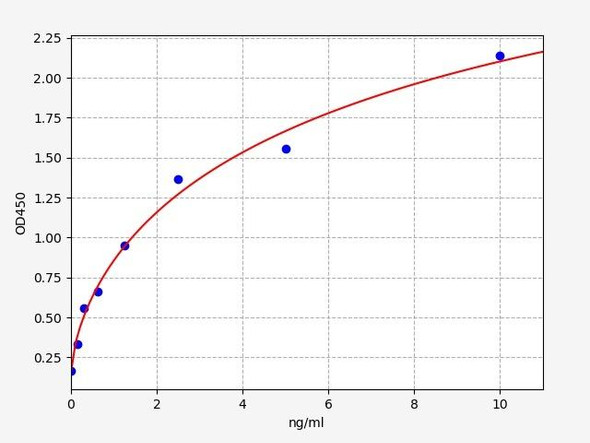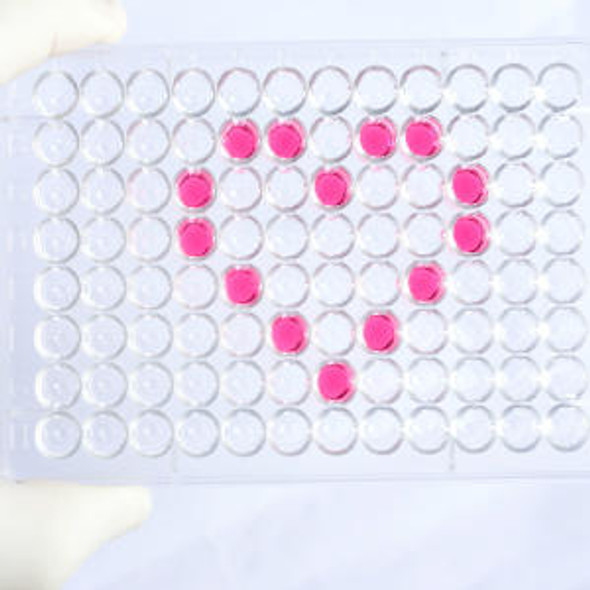Human BMP-10 (Bone Morphogenetic Protein 10) ELISA Kit (HUES01759)
- SKU:
- HUES01759
- Product Type:
- ELISA Kit
- Size:
- 96 Assays
- Uniprot:
- O95393
- Sensitivity:
- 0.09ng/mL
- Range:
- 0.16-10ng/mL
- ELISA Type:
- Sandwich
- Synonyms:
- BMP10, MGC126783
- Reactivity:
- Human
- Sample Type:
- Serum, plasma and other biological fluids
- Research Area:
- Cell Biology
Description
Human BMP-10 (Bone Morphogenetic Protein 10) ELISA Kit
The Human BMP-10 (Bone Morphogenetic Protein 10) ELISA Kit is specifically designed for the precise measurement of BMP-10 levels in human samples including serum, plasma, and cell culture supernatants. This kit offers exceptional sensitivity and specificity, ensuring accurate and reproducible results for various research purposes.BMP-10 is a key protein involved in regulating bone and cartilage development, as well as influencing cell differentiation and growth. It plays a critical role in various biological processes such as embryogenesis, organ development, and tissue regeneration.
Understanding the levels of BMP-10 in different biological samples can provide valuable insights into bone and cartilage-related disorders, as well as potential therapeutic interventions.Researchers and clinicians can rely on the Human BMP-10 ELISA Kit to enhance their studies on skeletal development, bone metabolism, and related diseases. With its user-friendly protocol and reliable performance, this kit is an essential tool for exploring the roles of BMP-10 in health and disease.
| Assay type: | Sandwich |
| Format: | 96T |
| Assay time: | 4.5h |
| Reactivity: | Human |
| Detection Method: | Colormetric |
| Detection Range: | 0.16-10 ng/mL |
| Sensitivity: | 0.10 ng/mL |
| Sample Volume Required Per Well: | 100µL |
| Sample Type: | Serum, plasma and other biological fluids |
| Specificity: | This kit recognizes Human BMP-10 in samples. No significant cross-reactivity or interference between Human BMP-10 and analogues was observed. |
This ELISA kit uses Sandwich-ELISA as the method. The micro ELISA plate provided in this kit has been pre-coated with an antibody specific to Human BMP-10. Standards or samples are added to the appropriate micro ELISA plate wells and combined with the specific antibody. Then a biotinylated detection antibody specific for Human BMP-10 and Avidin-Horseradish Peroxidase (HRP) conjugate are added to each micro plate well successively and incubated. Free components are washed away. The substrate solution is added to each well. Only those wells that contain Human BMP-10, biotinylated detection antibody and Avidin-HRP conjugate will appear blue in color. The enzyme-substrate reaction is terminated by adding Stop Solution and the color turns yellow. The optical density (OD) is measured spectrophotometrically at a wavelength of 450 nm ± 2 nm. The OD value is proportional to the concentration of Human BMP-10. The concentration of Human BMP-10 in samples can be calculated by comparing the OD of the samples to the standard curve.
| UniProt Protein Function: | Required for maintaining the proliferative activity of embryonic cardiomyocytes by preventing premature activation of the negative cell cycle regulator CDKN1C/p57KIP and maintaining the required expression levels of cardiogenic factors such as MEF2C and NKX2-5. Acts as a ligand for ACVRL1/ALK1, BMPR1A/ALK3 and BMPR1B/ALK6, leading to activation of SMAD1, SMAD5 and SMAD8 transcription factors. Inhibits endothelial cell migration and growth. May reduce cell migration and cell matrix adhesion in breast cancer cell lines. |
| NCBI Summary: | This gene encodes a secreted ligand of the TGF-beta (transforming growth factor-beta) superfamily of proteins. Ligands of this family bind various TGF-beta receptors leading to recruitment and activation of SMAD family transcription factors that regulate gene expression. The encoded preproprotein is proteolytically processed to generate the mature protein, which binds to the activin receptor-like kinase 1 (ALK1) and plays important roles in cardiovascular development including cardiomyocyte proliferation and regulation of heart size, closure of the ductus arteriosus, angiogenesis and ventricular trabeculation. [provided by RefSeq, Aug 2016] |
| UniProt Code: | O95393 |
| NCBI GenInfo Identifier: | 13123977 |
| NCBI Gene ID: | 27302 |
| NCBI Accession: | O95393. 1 |
| UniProt Secondary Accession: | O95393,Q53R17, Q6NTE0, |
| UniProt Related Accession: | O95393 |
| Molecular Weight: | 48,047 Da |
| NCBI Full Name: | Bone morphogenetic protein 10 |
| NCBI Synonym Full Names: | bone morphogenetic protein 10 |
| NCBI Official Symbol: | BMP10 |
| NCBI Protein Information: | bone morphogenetic protein 10 |
| UniProt Protein Name: | Bone morphogenetic protein 10 |
| Protein Family: | Bone morphogenetic protein |
| UniProt Gene Name: | BMP10 |
As the OD values of the standard curve may vary according to the conditions of the actual assay performance (e. g. operator, pipetting technique, washing technique or temperature effects), the operator should establish a standard curve for each test. Typical standard curve and data is provided below for reference only.
| Concentration (ng/mL) | O.D | Average | Corrected |
| 10 | 2.303 2.333 | 2.318 | 2.26 |
| 5 | 1.539 1.569 | 1.554 | 1.496 |
| 2.5 | 0.867 0.861 | 0.864 | 0.806 |
| 1.25 | 0.366 0.398 | 0.382 | 0.324 |
| 0.63 | 0.232 0.22 | 0.226 | 0.168 |
| 0.31 | 0.159 0.143 | 0.151 | 0.093 |
| 0.16 | 0.103 0.113 | 0.108 | 0.05 |
| 0 | 0.054 0.062 | 0.058 | -- |
Precision
Intra-assay Precision (Precision within an assay): 3 samples with low, mid range and high level Human BMP-10 were tested 20 times on one plate, respectively.
Inter-assay Precision (Precision between assays): 3 samples with low, mid range and high level Human BMP-10 were tested on 3 different plates, 20 replicates in each plate.
| Intra-assay Precision | Inter-assay Precision | |||||
| Sample | 1 | 2 | 3 | 1 | 2 | 3 |
| n | 20 | 20 | 20 | 20 | 20 | 20 |
| Mean (ng/mL) | 0.50 | 1.10 | 4.70 | 0.50 | 1.00 | 4.30 |
| Standard deviation | 0.03 | 0.06 | 0.19 | 0.03 | 0.04 | 0.13 |
| C V (%) | 6.00 | 5.45 | 4.04 | 6.00 | 4.00 | 3.02 |
Recovery
The recovery of Human BMP-10 spiked at three different levels in samples throughout the range of the assay was evaluated in various matrices.
| Sample Type | Range (%) | Average Recovery (%) |
| Serum (n=5) | 90-102 | 96 |
| EDTA plasma (n=5) | 93-105 | 100 |
| Cell culture media (n=5) | 92-103 | 98 |
Linearity
Samples were spiked with high concentrations of Human BMP-10 and diluted with Reference Standard & Sample Diluent to produce samples with values within the range of the assay.
| Serum (n=5) | EDTA plasma (n=5) | Cell culture media (n=5) | ||
| 1:2 | Range (%) | 98-113 | 98-113 | 86-99 |
| Average (%) | 104 | 105 | 91 | |
| 1:4 | Range (%) | 95-107 | 85-99 | 96-113 |
| Average (%) | 102 | 91 | 104 | |
| 1:8 | Range (%) | 100-111 | 84-98 | 96-111 |
| Average (%) | 106 | 91 | 102 | |
| 1:16 | Range (%) | 96-109 | 85-99 | 96-111 |
| Average (%) | 103 | 90 | 102 |
An unopened kit can be stored at 4°C for 1 month. If the kit is not used within 1 month, store the items separately according to the following conditions once the kit is received.
| Item | Specifications | Storage |
| Micro ELISA Plate(Dismountable) | 8 wells ×12 strips | -20°C, 6 months |
| Reference Standard | 2 vials | |
| Concentrated Biotinylated Detection Ab (100×) | 1 vial, 120 µL | |
| Concentrated HRP Conjugate (100×) | 1 vial, 120 µL | -20°C(shading light), 6 months |
| Reference Standard & Sample Diluent | 1 vial, 20 mL | 4°C, 6 months |
| Biotinylated Detection Ab Diluent | 1 vial, 14 mL | |
| HRP Conjugate Diluent | 1 vial, 14 mL | |
| Concentrated Wash Buffer (25×) | 1 vial, 30 mL | |
| Substrate Reagent | 1 vial, 10 mL | 4°C(shading light) |
| Stop Solution | 1 vial, 10 mL | 4°C |
| Plate Sealer | 5 pieces | |
| Product Description | 1 copy | |
| Certificate of Analysis | 1 copy |
- Set standard, test sample and control (zero) wells on the pre-coated plate and record theirpositions. It is recommended to measure each standard and sample in duplicate. Note: addall solutions to the bottom of the plate wells while avoiding contact with the well walls. Ensuresolutions do not foam when adding to the wells.
- Aliquot 100 µL of standard solutions into the standard wells.
- Add 100 µL of Sample / Standard dilution buffer into the control (zero) well.
- Add 100 µL of properly diluted sample (serum, plasma, tissue homogenates and otherbiological fluids) into test sample wells.
- Cover the plate with the sealer provided in the kit and incubate for 90 min at 37 °C.
- Aspirate the liquid from each well, do not wash. Immediately add 100 µL of BiotinylatedDetection Ab working solution to each well. Cover the plate with a plate seal and gently mix. Incubate for 1 hour at 37 °C.
- Aspirate or decant the solution from the plate and add 350 µL of wash buffer to each welland incubate for 1-2 minutes at room temperature. Aspirate the solution from each well andclap the plate on absorbent filter paper to dry. Repeat this process 3 times. Note: a microplatewasher can be used in this step and other wash steps.
- Add 100 µL of HRP Conjugate working solution to each well. Cover with a plate seal andincubate for 30 min at 37 °C.
- Aspirate or decant the solution from each well. Repeat the wash process for five times asconducted in step 7.
- Add 90 µL of Substrate Reagent to each well. Cover with a new plate seal and incubate forapproximately 15 min at 37 °C. Protect the plate from light. Note: the reaction time can beshortened or extended according to the actual color change, but not by more than 30min.
- Add 50 µL of Stop Solution to each well. Note: Adding the stop solution should be done inthe same order as the substrate solution.
- Determine the optical density (OD value) of each well immediately with a microplate readerset at 450 nm.






